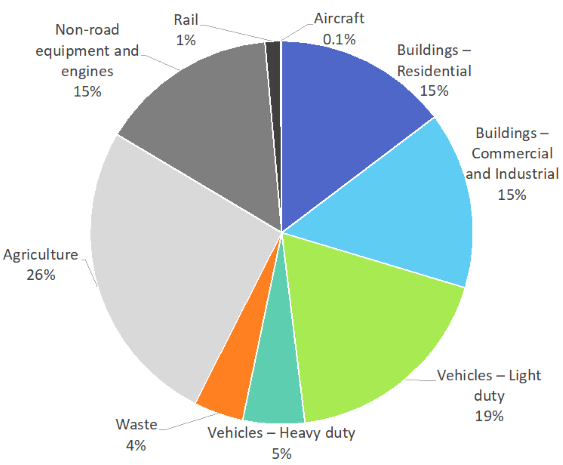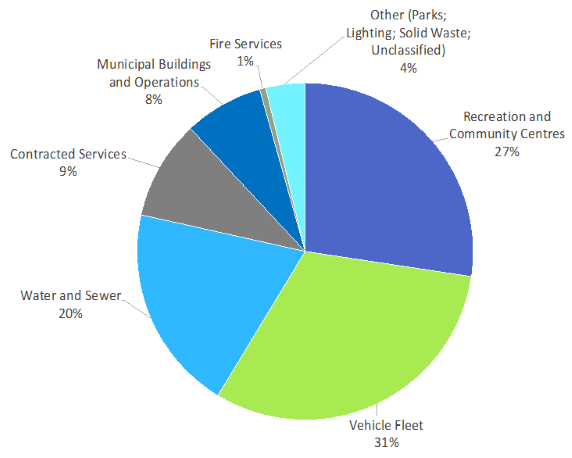Energy and Greenhouse Gases
What are Greenhouse Gases?
Greenhouse gases are gases that trap heat in the atmosphere. They persist in the atmosphere and result in a warmer planet when concentrations increase. Gases such as carbon dioxide, methane, nitrous oxide, and water vapour are all considered greenhouse gases. Greenhouse gases occur naturally and are part of our atmosphere’s natural makeup, but over the last century, humans have caused an increase in greenhouse gases in the atmosphere. The levels of carbon dioxide in the atmosphere have been rising steadily, causing the Earth’s surface temperature to increase. To prevent the Earth from warming to an unsustainable level, it is important that we act in preventing and limiting greenhouse gases in our community.
Community Greenhouse Gas Emissions:
Within the community, core activities undertaken by residents, businesses, and organizations that result in greenhouse gas emissions include: heating and cooling buildings, heating hot water, transporting people and goods, and the disposal of organic waste into the landfill.

In 2018, these activities resulted in approximately 411,600 tonnes CO2 emission (see Fig. 1):
• 26% from energy use in residential buildings, and 26% in commercial and industrial buildings.
• 41% from transportation.
• 7% from decomposing waste disposed in the landfill.
• Other sources that are not typically regulated by local governments include agriculture, non-road equipment and engines, and rail and aircraft.
Corporate Greenhouse Gas Emissions
With regards to activities undertaken by the City of Chilliwack, greenhouse gas emissions are produced by delivering services to residents, including emergency services, waste management, development planning and approval, recreation parks and trails, maintenance of roads and sidewalks, etc. These greenhouse gas emissions are created through emissions from fleet vehicles as well as operating facilities and infrastructure.

In 2020, City operations resulted in approximately 5,560 tonnes CO2e emissions, where the largest sources were the vehicle fleet (31%) and recreation/community centre operations (27%) – see Fig. 2:
CARIP Climate Action/Carbon Neutral Progress Reports
Under the, now ended, Climate Action Revenue Incentive Program (CARIP), the provincial government required local governments to publicly report on actions taken to reduce greenhouse gases. The Local Government Climate Action Program (LGCAP) launched in 2022 and requires the submission of a suvey. Copies of the City of Chilliwack's CARIP and LGCAP reports can be downloaded below.
| Attachments | |||
| Description | Date | File Size | |
| 2022 LGCAP Climate Action Survey | 2022-07-29 | 954KB | |
| 2023 LGCAP Climate Action Survey | 2023-09-18 | 263KB | |
| 2024 LGCAP Climate Action Survey | 2024-07-26 | 216KB | |
| 2025 LGCAP Climate Action Survey | 2025-07-31 | 226KB | |
| 2012 CARIP Climate Action/Carbon Neutral Progress Report | 2022-03-23 | 316KB | |
| 2013 CARIP Climate Action/Carbon Neutral Progress Report | 2022-03-23 | 148KB | |
| 2014 CARIP Climate Action/Carbon Neutral Progress Report | 2022-03-23 | 278KB | |
| 2015 CARIP Climate Action/Carbon Neutral Progress Report | 2022-03-23 | 188KB | |
| 2016 CARIP Climate Action/Carbon Neutral Progress Report | 2022-03-23 | 333KB | |
| 2017 CARIP Climate Action/Carbon Neutral Progress Report | 2022-03-23 | 526KB | |
| 2018 CARIP Climate Action/Carbon Neutral Progress Report | 2022-03-23 | 928KB | |
| 2019 CARIP Climate Action/Carbon Neutral Progress Report | 2022-03-23 | 807KB | |
